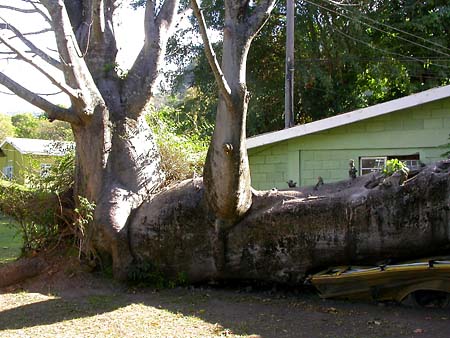
Something About Yardlong Bean a.k.a 'Kacang Panjang'
So, the picture above is a common sight of the yardlong beans being sold in fresh market in almost around the world. This beans really is quite a popular delicacy in some places such as my hometown which is Taiping. If you've never eat yard-long green beans, you're missing a real treat. I've been eating them since I was a child and never loathe with it. They are actually among the sweetest and most tender of the bean varieties. You can pick them, wash them, put them in a pot of boiling water and add some seasoning, and 10 minutes later serve them to your family. Yard-long green beans grow from 30 to 36 inches long but are best at about 12 inches. They are also call asparagus green beans or Chinese green beans.
This plant is of a different genus than the common bean. It is a vigorous climbing annual vine. The plant is subtropical/tropical and most widely grown in the warmer parts of South Asia, Southeastern Asia, Malaysia, and Southern China. It prefer hot and humid surroundings but some species can thrive in colder climate yet still sensitive to frost. A variety of the cowpea, it is grown primarily for its strikingly long (35-75 cm) immature pods and has uses very similar to that of the green bean. The many varieties of yardlong beans are usually distinguished by the different colors of their mature seeds. Some are cream colored while others are dark purple like a species that I've plant on my yard on following pictures.
Wrinkled mature beans which are no longer tasty to eat but suitable to be used as seeds supply. At this stage, you can actually see the seeds inside it when exposed to the sunlight.
Some newly collect 'Kacang panjang' seeds that I don't know exactly which species does it belongs.
Notice the difference between newly picked seeds on the left and dried seeds on the others.
The pods, which can begin to form just 60 days(or less based on climate and soil condition) after sowing, hang in groups of two or more. They are best for vegetable use if picked before they reach full maturity; however, overlooked pods can be used like dry beans in soups. When harvesting, it is important not to pick the buds which are above the beans; since the plant will set many more beans on the same stem. This plant takes longer time to reach maturity than bush beans; but once producing, the beans are quick-growing and daily checking/harvesting is often a necessity. The plants will produce beans until frost in 4 climate zone and continue throughout the year in tropical climate(with intensive care).
Four days after sowing in polystyrene cup.
After about 2 weeks, the plants are well-established and climb rapidly on that blue 'tali rafia'. In this picture, I've actually plant 2 individual plant in each hole for better bean produce.
UsesApproximately 5-6weeks after sowing, I was impressed by the amount of 'kacang panjang' it produces but quite frustrated with pests invasion that happens occasionally(like in that pic).
The crisp, tender pods are eaten both fresh and cooked. They are at their best when young and slender. They are sometimes cut into short sections for cooking uses. As a West Indian dish it is often stir-fried with potatoes and shrimp. They are used in stir-fries in Chinese cuisine. In Malaysian cuisine they are often stir-fried with chillies and shrimp paste (sambal), used in cooked salads (kerabu) mix in curry dish or cooked in endless variation of recipes. Another popular and healthful option is to chop them into very short sections(like the picture below), then fry them in an omelette. maybe you can eat it raw just like I always did with rice and other side dishes. Sometimes, I prefer to eat it with dippings like budu, cencaluk or sambal belacan to add more flavour to it.
Chopped long beans ready to be cooked.
Nutrition
They are a good source of protein, vitamin A, thiamin, riboflavin, iron, phosphorus, and potassium, and a very good source for vitamin C, folate, magnesium, and manganese.
In a serving size of 100 grams of yardlong beans there are 47 calories, 0 grams of total fat, 0 mg cholesterol, 4 mg sodium (0% daily value), 8 grams of total carbohydrates (2% daily value), and 3 grams of protein (5% daily value). There is also 17% DV vitamin A, 2% DV iron, 31% DV vitamin C, and 5% DV calcium. (Percent daily values are based on a 2000 calorie diet. Individual daily values may be higher or lower depending on individual calorie needs.)
Why You Should Eat Mango Often?
As one of the most celebrated tropical fruits out there, mangoes are characterized by its juicy, fibrous flesh and an oblong pit in the center which are so refreshing and delicious. The mango is actually distantly related to the cashew, pistachio, poison ivy, and poison oak; native to southern Asia and there are over 1,000 known cultivars of mangoes available. Mangoes are a good source of vitamins and minerals essential for the human body. It is an affordable and seasonal fruit. In India mangoes are grown widely in the southern belt. ‘Alphonso’ variety of mango which is exported world wide is cultivated in ‘Ratnagiri’ in the southern part of India. Mango is a popular garden fruit tree in Malaysia and is propagated commercially in small orchards. In most of Malay rural or sub rural areas, a mango tree is usually planted in lawn because it is such a tradition to plant tropical fruit tree around the house in Malaysia. More than that, its fruit and leaves are ritually used as floral decorations at weddings, public celebrations and religious ceremonies in several cultures.
 Mangoes can be eaten both raw and ripe. Raw mangoes have a sharp sour taste, while the ripe mangoes are juicy and sweet to eat. A ripe mango will also have a full, fruity fragrance that tingles ones taste buds and they're ready to eat when slightly soft to the touch and yielding to gentle pressure, like a ripe peach.
Mangoes can be eaten both raw and ripe. Raw mangoes have a sharp sour taste, while the ripe mangoes are juicy and sweet to eat. A ripe mango will also have a full, fruity fragrance that tingles ones taste buds and they're ready to eat when slightly soft to the touch and yielding to gentle pressure, like a ripe peach. To accelerate ripening, place your mangoes in a paper bag overnight. Once the mangoes are ready to eat, you can store them in the refrigerator for up to three days. To prepare a mango for eating, wash thoroughly, slice in half lengthwise, avoiding the pit in the center. Hold one mango half skin side down and score into 1/2 inch squares. Then, using your thumbs, push the mango inside-out, and you have ripe and delicious squares to eat out of hand or use in recipes.

Unripe mango
Vitamin Content: Mango is rich in Vitamin C and Vitamin A. Vitamin C content is more in raw mango as compared to that in ripe mango. It also has traces of Vitamin E, Vitamin B and Vitamin K. The dulcet, juicy insides of the mango pack a nutritional punch. Its characteristic orange color is a clue to its storehouse of beta carotene (Vitamin A). Ripe mangos hold the highest levels of beta carotene, while green mangos are higher in Vitamin C. These antioxidant carotenoids are known for their protective power against certain cancers. Mangos also supply ample potassium, making them ideal for hypertensive patients or anyone looking to replenish energy after physical activity.
Cross section of a fully ripe mango
Mangoes are high in antioxidants, low in carbohydrates (although they are about 15% sugar – but good sugar!) and like other yellow/orange fruit such as pumpkin and carrot, they are an excellent source of beta-carotene (Vitamin A). They also contain Vitamin E and selenium which help protect against heart disease and cancer. You can obtain 40% of your daily fibre intake from a mango.
We all know the importance of fiber in our diets. If you are eating your mango-a-day, irregularity is not a problem for you and so we’ll spare the gruesome details regarding constipation, piles and spastic colon. Research has shown that dietary fiber has a protective effect against degenerative diseases, especially with regards to the heart; may help prevent certain types of cancer, as well as lowering blood cholesterol levels.
Semi-ripe mango (sweet sour)
The nutritional value of mango makes it good for weight gain, eye disorders, hair loss, heat stroke, prickly heat, diabetes, bacterial infections, sinusitis, piles, indigestion, constipation, morning sickness, diarrhea, dysentery, scurvy, spleen enlargement, liver disorders, menstrual disorders, leucorrhea, and vaginitis.
Mango, being high in calories and carbohydrates, is good for those who are trying to gain weight. The phenolic compound found in mangoes has been found to have powerful antioxidant and anticancer properties. Being high in iron, mango is said to be very good for pregnant women as well as for people suffering from anemia. Mango is believed to be effective in relieving clogged pores of the skin.
Labels:
Tree
,
Tropical Fruit
Subscribe to:
Posts
(
Atom
)
















































